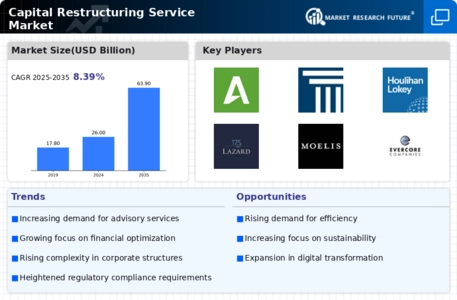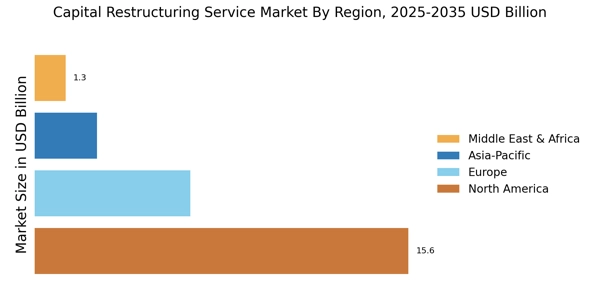Global Economic Uncertainty
The Capital Restructuring Service Market is significantly impacted by global economic uncertainty, which drives companies to reassess their financial strategies. Economic fluctuations, geopolitical tensions, and market volatility compel organizations to seek restructuring services to navigate challenging environments. As firms face pressures related to cash flow and profitability, the demand for expert guidance in capital restructuring is likely to increase. Recent economic indicators suggest that many sectors are experiencing instability, prompting businesses to prioritize financial resilience. The Capital Restructuring Service Market is expected to see heightened activity as companies proactively engage in restructuring initiatives to safeguard their financial health amid uncertainty.
Increased Regulatory Scrutiny
The Capital Restructuring Service Market is significantly influenced by heightened regulatory scrutiny across various sectors. Governments and regulatory bodies are implementing stricter compliance measures, compelling organizations to reassess their financial strategies. This environment creates a pressing need for expert guidance in capital restructuring to ensure adherence to evolving regulations. Companies are increasingly turning to restructuring services to navigate the complexities of compliance while optimizing their capital structures. The demand for advisory services in this context is expected to rise, as firms seek to mitigate risks associated with non-compliance. Furthermore, the Capital Restructuring Service Market is likely to benefit from the growing emphasis on transparency and accountability in financial reporting, which necessitates a thorough evaluation of capital arrangements.
Rising Demand for Financial Restructuring
The Capital Restructuring Service Market experiences a notable increase in demand as companies seek to optimize their financial structures. This trend is driven by the need for organizations to enhance operational efficiency and improve liquidity. In recent years, many firms have faced challenges related to debt management and capital allocation, prompting them to explore restructuring options. According to recent data, the market for capital restructuring services is projected to grow at a compound annual growth rate of approximately 5% over the next five years. This growth indicates a robust interest in financial advisory services that can assist companies in navigating complex financial landscapes. As businesses strive to remain competitive, the Capital Restructuring Service Market is likely to see a surge in activity as firms prioritize financial health and sustainability.
Shift Towards Sustainable Business Practices
The Capital Restructuring Service Market is witnessing a shift towards sustainable business practices, as organizations increasingly recognize the importance of environmental, social, and governance (ESG) factors. This trend is prompting companies to reevaluate their capital structures to align with sustainability goals. As firms seek to attract socially conscious investors, the demand for restructuring services that incorporate ESG considerations is on the rise. Recent studies indicate that companies with strong ESG performance tend to experience lower capital costs and enhanced financial stability. Consequently, the Capital Restructuring Service Market is likely to see a growing number of firms engaging in restructuring initiatives that prioritize sustainability, thereby enhancing their long-term viability and appeal to investors.
Technological Innovations in Financial Services
The Capital Restructuring Service Market is being transformed by technological innovations that enhance financial analysis and decision-making processes. Advanced analytics, artificial intelligence, and machine learning are increasingly being integrated into restructuring services, allowing for more accurate assessments of financial health and potential restructuring outcomes. These technologies enable firms to analyze vast amounts of data quickly, leading to more informed decisions regarding capital allocation and restructuring strategies. As a result, the demand for technologically advanced capital restructuring services is expected to rise. Companies are likely to seek out service providers that leverage these innovations to gain a competitive edge in the market. The Capital Restructuring Service Market stands to benefit from this trend, as firms prioritize data-driven approaches to financial restructuring.


















Leave a Comment